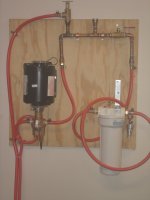After much discussion I finally built a Muzzle Flush System. I made the rotary coupling from an air tool swivel joint and a piece of 2" aluminum bar stock I had. The aluminum bar stock was constructed to accommodate three main sizes of barrel, 1.250", 1" and .750". I connected the aluminum fitting to the swivel joint with 1/4" NPT threads. I'll connect the barrels via hose clamps and the appropriate size hose. All I need now is the oil/coolant, the reservoir and a catch pan for the oil/coolant to flow into when it leaves the barrel. Thanks to all.
William
William



